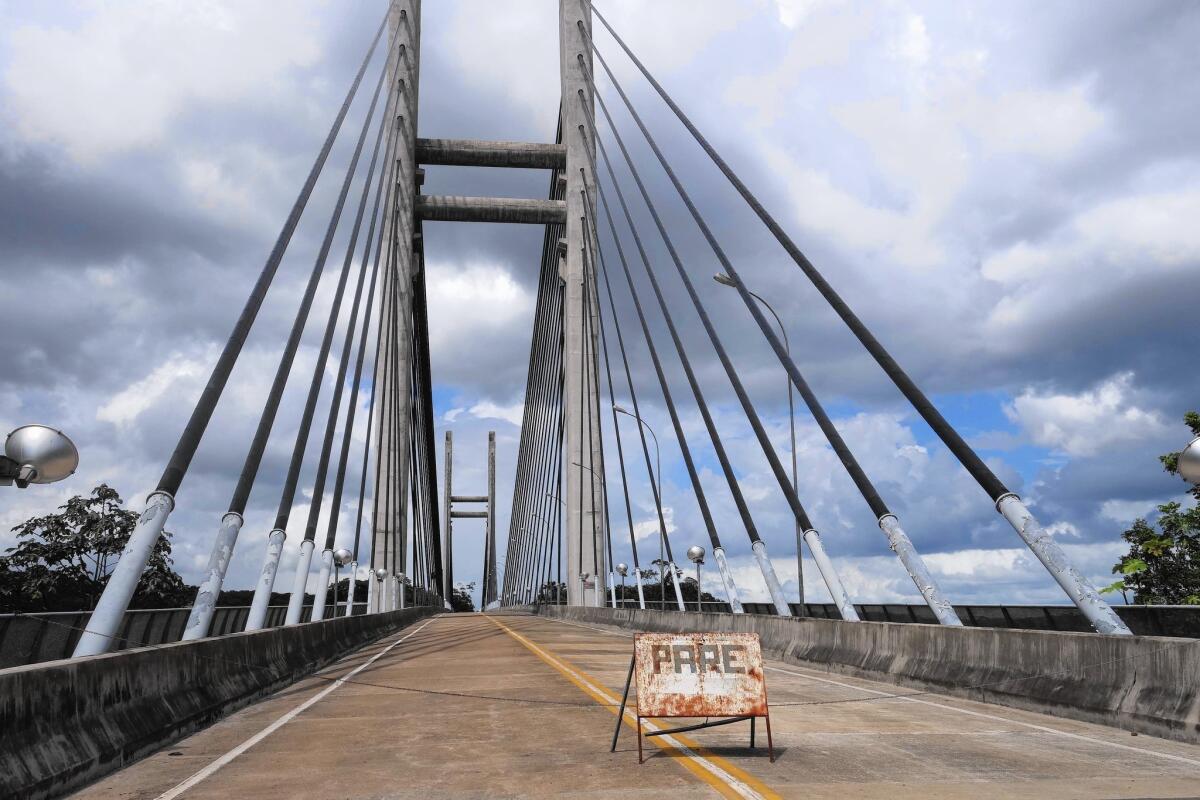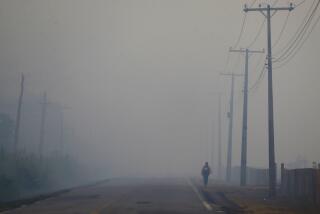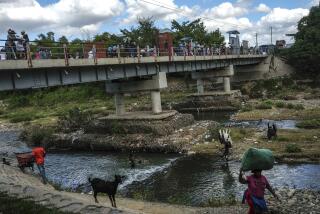Great Read: Bridge links Brazil to French Guiana, yet doesn’t

A mammoth suspension bridge in the Amazon connects Brazil and French Guiana, but remains off-limits to travelers and commuters.
- Share via
Reporting from Oiapoque, Brazil — As Jose Domingos speeds down the Oiapoque River in his canoe once more today, he passes underneath a mammoth suspension bridge. By far the most imposing structure anywhere near this muggy Amazonian border town, it looms overhead and then retreats behind him as he moves across the brown water.
The bridge connects Brazil to French Guiana, the only piece of land on the South American mainland that is still part of a former colonial power. But even though it was finished two years ago, it still hasn’t opened. On the Brazilian side, a tiny, rust-covered sign reads simply: Stop.
For Oiapoque, a town that time and the rest of Brazil seem to have forgotten, it might as well be a bridge to nowhere.
Samuel Nogueira, a passenger on Domingos’ canoe, passes under it every day as he goes to work.
Nogueira checks his phone absent-mindedly for something to distract him on the 15-minute commute to his job in French Guiana, but there’s never any service in Oiapoque, which locals generously call the “beginning of Brazil.” So he returns to watching the thick forest pass him by.
“Of course, if the bridge were actually in operation, my life would be much easier,” says Nogueira, who lives in Brazil but works washing cars in French Guiana, earning the more valuable euros. “But I can’t complain about this ride either. It’s insanely beautiful.”
Although people here curse the Brazilian government for the mysterious delay, and blame what they say must be incompetence or corruption, no one in town knows for sure why the bridge hasn’t opened.
“Only Jesus knows,” says Manuel da Veracruz, who has worked as a catraeiro, or canoe shuttle driver, for more than 20 years. “It could be [2015], it could be 2016, it could be never.”
::
Oiapoque has the feel of a place in a magical realist novel, an intensely hot town spread over a few streets along the Oiapoque River that is at once sleepy and famous for the vices common in border outposts.
To reach it from the nearest Brazilian state of Para, where car-washer Nogueira was born, most visitors have to take a boat through the Amazon for 24 hours or more. Hundreds of people sweat and sway on hammocks as the boat winds through the dark green jungle.
Once they arrive in Macapa, the capital of Amapa state, they still have to spend 10 hours on a truck or 4x4 bus that can make it over the unpaved roads to Oiapoque.
It serves as a last stop for the Brazilians heading into French Guiana, where the pay is better. They head for the capital, Cayenne, where some Brazilians can work legally; a de facto free zone near the river (the French gendarmes check passports later, along the highway miles into the country); or up the coast to illegally fish or pan for gold.
In the years since the bridge was finished, residents have been watching and waiting to see how their lives will change.
“Our job will be over, at least in its current form,” says Jose Domingues Carvalho Pinto, president of one of the two canoe taxi cooperatives. He says they’ll find new jobs or try to shift to tourism along the river, if the bridge brings more people in.
“Our fear is that people simply won’t stop in Oiapoque at all anymore. We don’t even have a town square. Do you see anything around here worth stopping for?”
In the same breath that canoe drivers and others worry about how their lives will change when the bridge opens, they blame the Brazilian government for the delays.
“We have to hold this government accountable. They don’t do anything. Bunch of thieves,” says David Nascimento, 32, an automobile taxi driver who has been waiting for years now to transport passengers over the bridge.
He cruises toward the bridge, past the dirt and rocks of an unfinished customs outpost on the Brazilian side. He stops to chat with the security guard about when it may open, or how the border rules with France, as the neighboring country is called here, will work. He doesn’t know.
“I used to work over in France, as a waiter. But the cops over there are so annoying, always caring about who has papers or who doesn’t. Now I have my papers in order for both sides, and I make more driving here.... I’m just waiting for the link to open up,” Nascimento says, fiddling with the radio before driving away.
::
The bridge to connect Brazil to French Guiana has long been an official priority of both governments. The project was initially developed by then-Presidents Nicolas Sarkozy of France and Luiz Inacio Lula da Silva of Brazil, but then passed on to their respective successors, Francois Hollande and Dilma Rousseff.
Over past years, though, construction delays in Brazil’s push to develop became frustratingly common, and the country failed to meet a majority of its promised infrastructure improvements before the World Cup in June and July.
With a completed highway and bridge, French Guiana would be easier to reach for many Amapa state residents than any other part of Brazil. And it would open up the small country.
French Guiana is not just controlled by France — it is France, just as much as Hawaii is the United States. Downtown Cayenne, three hours on good roads from the border, consists of quaint, low-slung colonial architecture, and Chinese and Brazilian immigrants work alongside Francophone locals in its restaurants and shops. Food, just like television, is imported from France.
If the bridge opened up, however, they’d be able to import goods directly from Brazil. As it is, just some items, such as huge watermelons, make it across on canoes.
The prefect of Guiana, the representative of the French president in Guiana, blames the deadlock on the delays on the Brazilian side.
“The bridge has effectively been done for two years … however, the Brazilians are not ready. In fact, even if the [customs] facility on the Brazilian side were finished, the Brazilian police have no one to control the border,” says Prefect Eric Spitz, adding that there is no road to Oiapoque from any Brazilian population center and that Brazilian insurance doesn’t cover drivers in French Guiana.
On the Brazilian side of the border, the outgoing governor of Amapa state, Camilo Capiberibe, said a few days later he was “very optimistic” the project will be finished, perhaps even this year.
Speaking from the governor’s residence overlooking the Amazon River in Macapa, Capiberibe said not all the blame should be placed on Brazilian construction delays.
“There’s also a problem of political will to sign all the accords between the two countries,” Capiberibe said. “On the French side, authorities are afraid of what the opening of the bridge will mean.”
Brazilians need a visa to enter French Guiana, but the French enter Brazil freely, he said.
But for now, any thorny diplomatic issues still take a back seat to the construction holdup. Brazil’s federal government just didn’t realize how hard it is to get to the border and build there, Capiberibe said.
“Amapa is very far away from [the capital] Brasilia. And then, to think about a project in Oiapoque, it’s not easy,” he said. “I think the government couldn’t imagine what it would be like.”
::
As Brazil’s boom ended, and development promises went unkept, many Brazilians have resigned themselves to life as it is, unsure what will come next.
Val Barata is one of the Brazilians who live and work in Cayenne, where she serves breakfast at the Best Western Hotel Amazonia. On this day, she and her children have gone into Oiapoque to visit their dentist, and are now returning to French Guiana on a canoe taxi.
As their canoe pulls into Saint-Georges across the river from Oiapoque, a sunburned Frenchman sips red wine in front of his small restaurant despite 95-degree heat.
Saint-Georges is even sleepier than Oiapoque, and the only sound downtown comes from three schoolboys in the dusty central square, giggling and talking in French and Portuguese as they watch the “Wiggle” video, by Jason Derulo and Snoop Dogg, on one boy’s cellphone.
“I don’t actually really like it here so much,” Barata says, though she acknowledges the money is good and life is calm. “If the bridge were to open, I think a lot more Brazilians would want to move into France, but I bet they’d face prejudice and maybe a reaction from the government.”
As she heads into Cayenne, her canoe driver, Mauro Capucho, heads back across the river to Brazil. He’s glad the government seems to have forgotten about Oiapoque. It’s good for business.
But taxi driver Nascimento doesn’t like feeling abandoned.
“For us, this is the beginning of Brazil,” he says. “But for the rest of the country, we are the end of the world.”
Bevins is a special correspondent.
More to Read
Sign up for Essential California
The most important California stories and recommendations in your inbox every morning.
You may occasionally receive promotional content from the Los Angeles Times.













